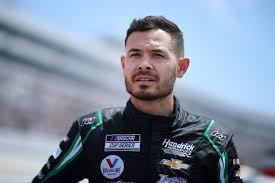
Kyle Larson Defends Austin Dillon’s Aggressive Move in Homestead Race
At the recent Straight Talk Wireless 400 held at Homestead-Miami Speedway, Austin Dillon found himself at the center of controversy following a daring move that sparked heated discussions across the NASCAR community. As the race progressed, Dillon made a bold, calculated maneuver that positioned him for a better finish, but it also led to some tension on the track. While some saw the move as reckless, NASCAR driver Kyle Larson has since stepped up to defend Dillon’s actions, emphasizing the nature of competitive racing and the pressures that come with it.
In the race, Dillon’s move involved passing an opponent in a manner that many believed was too aggressive, especially given the potential risks involved for both his car and others on the track. Dillon, who is known for his bold driving style, took an inside line that required a high level of control and confidence in his car’s capabilities. However, this line ultimately cut off another driver, which could have resulted in a wreck. Many fans and analysts questioned whether such tactics were necessary or respectful of his fellow drivers, given the stakes and potential consequences.

When questioned about Dillon’s move, Kyle Larson came forward with an insightful perspective on the incident. Larson pointed out that what may seem overly aggressive from a spectator’s viewpoint often appears different in the driver’s seat. “You have to understand the intense pressure and split-second decision-making that goes into every move on the track,” Larson explained. He noted that in high-stakes races like those in the NASCAR Cup Series, drivers are constantly balancing competitive instincts with the need for safety and race strategy.
Larson also highlighted that Dillon’s actions were driven by a clear desire to maximize his position, a mindset that every driver on the track shares. In Larson’s view, Dillon’s move was a result of his hunger to compete and secure a good result in a race that was critical to his season standing. The NASCAR Cup Series, as Larson emphasized, is not just about speed but also about the mental resilience to make tough calls and live with the outcomes.
Adding to his defense, Larson remarked that the NASCAR community is filled with different driving styles and personalities, which contributes to the sport’s dynamic nature. Some drivers are more conservative, while others, like Dillon, are willing to take risks if it means a shot at a higher placement. Larson acknowledged that not every driver would have taken the same approach, but he argued that Dillon’s choice was not out of line. “Racing is a battle, and Austin was simply fighting for his ground,” Larson added.
For NASCAR fans, the incident has reignited the debate over what constitutes fair play versus recklessness on the track. While some fans and analysts argue for more restraint and caution, others feel that the sport’s appeal lies in the high-risk, high-reward nature of the competition. Dillon’s move, while divisive, showcases the split opinions on what NASCAR should be—an arena for daring and calculated risks or a domain of more measured strategy.
In the end, Larson’s defense of Dillon highlights the unique challenges NASCAR drivers face as they juggle speed, skill, and strategy under pressure. Whether or not Dillon’s move will affect future race tactics remains to be seen, but with Larson’s support, Dillon has certainly found an ally who understands the complex decisions drivers must make in pursuit of victory.
Leave a Reply